Film, Radio and TV - 1 |
|
Film: How It All Started
It started with a $25,000 bet. In 1877, that was a lot of money. Edward Muybridge, an Englishman tuned American, needed to settle a bet. The problem was that galloping hooves move too fast for the eye to see. Or, maybe, depending on your belief, just fast enough that you could see what you wanted to. Definitive proof was needed. To settle the bet once and for all--the argument had been raging for decades--Muybridge hired a photographer to set up 24 cameras along a race track to snap still pictures in a rapid sequence as a horse galloped by. When the pictures were developed, it was found that the horse did indeed have all four feet off the ground during brief moments, thus, settling the bet. But, during this process they found out something else--something that was to eventually make that $25,000 look like pocket change. When the pictures were viewed in rapid succession, an illusion of motion was created. A motion picture! Later, we would give impressive names to the two factors that created this illusion of motion--the illusion that lies at the base of both motion pictures and television.
Motion picture projectors present images much faster, at 24-frames per-second, with each of those frames flashed on the screen twice. This high speed makes the transition between images virtually invisible. So, as a result of a $25,000 bet, the foundation for motion pictures and television was inadvertently established. But, let's not get ahead of ourselves. Although the foundation may have been laid, watching a series of drawings or still photos flip by is very different than sitting back and watching a movie. To see how the process got started, we need to back up to 1822. In that year, Joseph Nicéphore Nicepce in France was first able to produce a crude photographic image. But, it was Lous Daguerre in 1839, who came up with a process that could actually be considered photography. His photos were referred to as daguerreotypes. (Note: If you invent something, you can name it after yourself and be famous throughout history!) But, there were obvious problems with this process--in addition to everyone having to learn how to spell daguerreotype. The only way to capture real-life images was to make metal plates light-sensitive by painting them with a liquid solution while you were in a darkroom, and then running out and exposing them one at a time in a camera, and then running back into the darkroom and developing them. Not a simple or fun process. A gentleman by the name of Hannibal Goodwin greatly simplified the process in 1889, when he developed a transparent, pliable film base called celluloid. The next step was to create long strips of film where a series of still pictures could be captured in rapid succession. Cameras and projectors were developed that could do this at a rate of 16 frames per-second. (The rate was later moved up to 18, and eventually to 24 per-second.) A few years later the concept was adopted by George Eastman of Eastman Kodak fame. He added some of his own innovations, and eventually standardized the film for cameras and projectors.
Once the principle of creating the illusion of motion from a series of still images was realized, a host of devices were invented to fascinate anyone who wanted to watch (for a price) "moving images." Unfortunately, all of these devices had the disadvantage of only allowing "an audience of one." Generally, a single peephole was provided behind which a series of drawings or photos were presented in rapid sequence. Thomas This, of course, turned out to be a major marketing miscalculation--just one of the many that would become a part of film, radio and TV history. (And we might include the world of computers if we remember the IBM executive in the early days of computers who said that a half a dozen computers would be all the world could ever use!) For a more complete outline of Edison's life and inventions, Meanwhile, around the world, scores of inventors had introduced their own "movie machines." In fact, so many motion picture devices appeared at about the same time that no one person can truly be credited with the invention. People in England, France, Germany, and the United States all came up with motion picture devices at about the same time. According to popular history, it was the Lumière brothers in France who first did what Edison In 1895, they started producing a series of short films--as in really short--30 to 60 seconds. They started showing them in a Paris cafe, charging a one-franc admission. These films covered such blockbuster issues as a man falling off a horse and a child trying to catch a fish in a fishbowl. (It didn't take much to excite an audience in those days.) Meanwhile, back in the United States, Edison eventually saw the light, and devised his own projector--but, not until some other Americans forced his hand by introducing their own projector, the vitascope. Edison then came up with the concept of a battery operated motion picture camera. Interestingly, he didn't seem to have much confidence in the long-range possibilities of either the camera or his kinetoscope. When he applied for patents, he didn't pay the extra $150 required to secure an international copyright. That little oversight would cost him millions in profits in the coming years. (On the other hand, they also said TV would be a passing fad!) After George Eastman bought the rights to make celluloid (film), he standardized the film gage (size) so that it could be readily used in different types of production equipment. The film was 35mm wide and had sprocket holes on each side. Gear teeth fit into these holes, making it possible to pull the film through cameras and projectors at a steady rate. The images on the film were each 1X3/4-inch (2.5 x 2 cm) in size. Later, a sound track would be added on one side of the film next to the sprocket holes.
During viewing, if the production was longer than what could fit on one reel, the projector had to be stopped and the audience given an intermission while one reel was taken down and another loaded. Later, two projectors would be used so that the film reels could be alternated between projectors, making an instant switchover possible. As we noted, the first film gauge (size) to be standardized was 35mm. Today, some 120 years later, this is still the standard film gage for motion picture work. (Later, the 16mm and 8mm film gauges would be added.) Once a basic film gauge was adopted, cameras and projectors could be manufactured without fear of major incompatibilities in the marketplace. At this point the foundation for motion pictures was in place.
During this time, vaudeville (small theaters that featured short dramatic skits, comedy routines, and song and dance numbers) was quite popular. In order get one-up on the competition and fill in time between acts, vaudeville theaters started featuring short films. As the 1900s dawned, vaudeville expanded into nickelodeons, which were small storefront-type theaters that featured films (accompanied by piano music and sound effects) along with one or two vaudeville acts. As the name suggests, admission was one nickel, a price that appealed to working class citizens. As the films got more popular and longer, the vaudeville acts disappeared from the nickelodeons and the motion picture theater was born--if you can call a small room with wooden benches a motion picture theater. Since nickelodeons only charged a five-cent admission fee, they had to depend on audience turnover to generate profits. This meant that movies had to be changed regularly--sometimes even daily--to keep people coming back. Obviously, early studios had to turn out large numbers of films to meet the demand. The studios of the early 1900s were appropriately called "film factories." At that time they were primarily located in New York and New Jersey. As we will see, this would soon change.
It was an employee of Thomas Edison, Edwin Porter, who in Porter's film had 14 scenes and lasted 12 minutes, a real epic by the standards of the day. Before that, films were shot from a single wide-shot camera position while actors paraded in front of the camera--a stage play on film, only you couldn't hear the actors speak, and the whole thing was in black and white. Before the The Great Train Robbery, people were starting to get bored with films. The novelty of the short films was wearing off, plus audiences could see things--not to mention hear them--much better in stage plays.
Actually, Porter had stolen some of his ideas from European films--primarily from a Frenchman named Georges Méliès, a man credited with virtually inventing special effects with his film, Trip to the Moon. The film editor's job in those days was simple; just take out the film leader at the beginning and ends of reels and splice the whole thing together. Strangely, during the early days of film, some producers resisted the use of close-ups, arguing that they had paid for the whole actor, so they wanted to see the whole actor at all times. (With their eyes focused squarely on money, maybe they should have reasoned that if close-ups were used, they should only have to pay about 1/4th the full actor's wages.) The Dawn of Film Censorship
Interestingly, these same censors didn't seem to mind that in The Great Train Robbery several men were shot and one was even thrown off the top of a moving train. So kissing people was obscene, but killing them was okay. Go figure. Responding largely to the public and political pressure of the day, the U.S. Supreme Court officially denied motion pictures the same First Amendment freedom that was being given to the press, literature, and the theater. In deciding against the Mutual Film Corporation, they used the argument that films were amusements and not artistic works--a decision that would seem to instantly elevate the theater and the press to art forms! As a result of the Supreme Court decision, film censorship boards sprung up in most states to make sure that films shown in their area adhered to their particular view of morality. Almost 50 years later, the Supreme Court reversed itself, finally allowing films the same First Amendment protection as the other mass media. Even so, for several decades after this decision many state censorship boards hung on to their power over film content. Many would later redefine their purpose as being "advisory." We'll discuss the MPAA motion picture rating system--PG, PG-13, R, etc.--later. The Accidental Beginnings of Editing In the early days, film action resembled a, simple, short stage play--continuous and not interrupted. This allowed a new film to be churned out every few days. It is said that the whole idea of instantly cutting from one scene to a different scene resulted from desperation on the part of a director one day when he had to stick to a very tight schedule. A mishap occurred while filming a particular scene, and he didn't have time to start the scene all over again from the beginning--the normal price you had to pay for such problems in those days. To keep from falling behind on the schedule, the director just ordered the camera to stop until things were sorted out, and then to start the camera and action again. Afterwards, the two scenes were spliced together.
By the late 1800s, it had become accepted practice to stop and reposition the camera, and even to cut directly to a totally different scene in telling a story. (To keep them from being confused, audiences had to be slowly educated to these techniques.) At this point there still wasn't sound or color. Dialogue initially There was one major advantage of this "silent" approach: it was easy to change the dialogue into any language, which meant that the films could readily be exported to other countries. As we will see, this issue represented a major stumbling block when sound was introduced. In the next section we'll talk about some of the famous people and films of the early motion picture era, along with some of the controversy that surrounded the industry. |
|
Click on TO NEXT MODULE below for the next part of film history. |
|
To next module To index © 1996 - 2005, All Rights Reserved
|
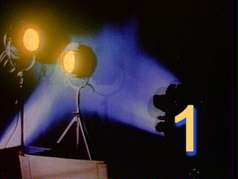
 Some people argued that a galloping horse had all four feet off of the ground at the same time at some point; others said this would be impossible. (No feet touching the ground; how could that be!?)
Some people argued that a galloping horse had all four feet off of the ground at the same time at some point; others said this would be impossible. (No feet touching the ground; how could that be!?) In actual fact, there is nothing moving in motion pictures. It's all an illusion based on these two phenomena. Note in the illustration on the left that an illusion of motion is created, even when successive pictures are presented at a relatively slow rate.
In actual fact, there is nothing moving in motion pictures. It's all an illusion based on these two phenomena. Note in the illustration on the left that an illusion of motion is created, even when successive pictures are presented at a relatively slow rate.
 Edison, of electric light bulb and phonograph fame, liked the fact that only one person at a time could see the images. Edison's company had devised the peephole kinetoscope, and he was making a bit of money selling these devices. Edison thought that if he came up with a system to show motion pictures to a large audience, then everyone would be able to see them at the same time and he wouldn't sell nearly as many kinetoscopes.
Edison, of electric light bulb and phonograph fame, liked the fact that only one person at a time could see the images. Edison's company had devised the peephole kinetoscope, and he was making a bit of money selling these devices. Edison thought that if he came up with a system to show motion pictures to a large audience, then everyone would be able to see them at the same time and he wouldn't sell nearly as many kinetoscopes.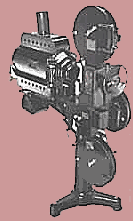 initially didn't want to do--devise a projector that could show motion pictures on a screen for an audience. They called their invention cinematographe.
initially didn't want to do--devise a projector that could show motion pictures on a screen for an audience. They called their invention cinematographe.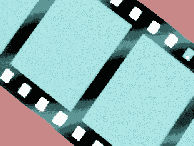
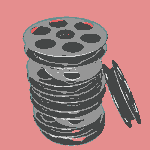 The celluloid film was wound on reels, as shown on the right. Since the reels only held about 12 minutes of film, they regularly had to be changed during filming.
The celluloid film was wound on reels, as shown on the right. Since the reels only held about 12 minutes of film, they regularly had to be changed during filming.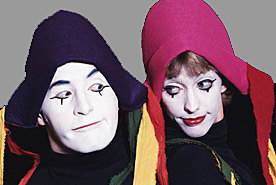
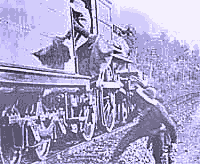 1903, created the first U.S. narrative film, The Great Train Robbery. With this film, a real story line involving crosscutting between different narrative sequences and different camera positions and distances, were all introduced.
1903, created the first U.S. narrative film, The Great Train Robbery. With this film, a real story line involving crosscutting between different narrative sequences and different camera positions and distances, were all introduced.
 Using a motion picture camera like the one on the left, Porter not only introduced the western as a film genre (which subsequently spawned a few thousand films of the same ilk), he also demonstrated that suspense could be introduced into films by alternating shots of "the bad guys" doing their illegal thing and "the good guys" trying to bring them to justice. In this regard not much has changed in the last century.
Using a motion picture camera like the one on the left, Porter not only introduced the western as a film genre (which subsequently spawned a few thousand films of the same ilk), he also demonstrated that suspense could be introduced into films by alternating shots of "the bad guys" doing their illegal thing and "the good guys" trying to bring them to justice. In this regard not much has changed in the last century.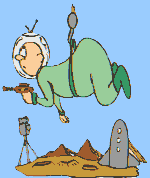
 One of the very first films produced in the United States, called The Kiss, was based on a scene from the stage play, "The Widow Jones." Groups tried to get the film banned because it showed a man and a woman kissing--something that moralists of the time thought was obscene.
One of the very first films produced in the United States, called The Kiss, was based on a scene from the stage play, "The Widow Jones." Groups tried to get the film banned because it showed a man and a woman kissing--something that moralists of the time thought was obscene. Later, kisses were deemed okay, as long as they didn't exceed a few, brief seconds--after which they were seen as inappropriate and had to be censored.
Later, kisses were deemed okay, as long as they didn't exceed a few, brief seconds--after which they were seen as inappropriate and had to be censored.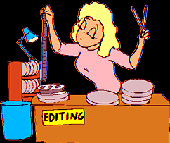 The director apparently hoped that no one would notice, or at least not complain too much. But after viewing "the mistake," it was concluded that the "lost" footage wasn't really necessary, and the jump in action actually speeded things along.
The director apparently hoped that no one would notice, or at least not complain too much. But after viewing "the mistake," it was concluded that the "lost" footage wasn't really necessary, and the jump in action actually speeded things along.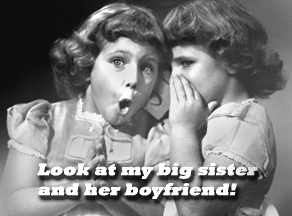 appeared as full-frame text on the screen after actors spoke their lines. Later, the dialogue was superimposed over the picture, as shown here.
appeared as full-frame text on the screen after actors spoke their lines. Later, the dialogue was superimposed over the picture, as shown here.